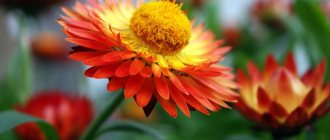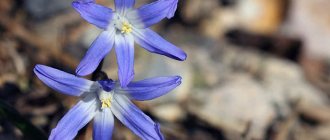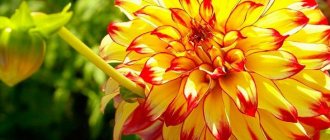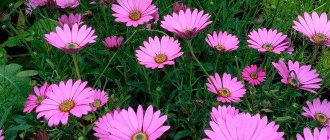Brachycoma - amazing in its unpretentiousness, long-flowering plant from the Asteraceae family.
The variety of colors, a cap of corollas throughout the season and absolute unpretentiousness make it a real find for any flower garden.
Let's figure out what brachycoma is and how to breed it on your site.
Description
In central Russia and Siberia, brachycoma is grown as an annual plant, since it does not tolerate harsh winters .
But in regions with milder winters it can be cultivated as a perennial.
The height of the branched bush does not reach half a meter, but in some varieties it is less. The inflorescences form a basket, the diameter of which reaches 40 mm.
A distinctive feature of brachycoma is its lush flowering; up to 100 flowers can open simultaneously on one bush.
The color and shape of the petals (smooth or terry) depend entirely on the varietal characteristics of the plant.
Interesting! The flowering of brachycoma does not depend on weather conditions and other factors. It lasts up to 90 days continuously.
Biological features
This flower from the Astrov family was common in Australia, but after it came to Europe, it was known on almost all continents within 50 years. Almost all species are annuals, but there are also perennial representatives of the genus. Most of those cultivated in southern latitudes tolerate winter well if there is no frost. The bushes are low, maximum 30-35 cm in height, and at the same time they actively branch, forming a dense crown. In the description, brachycromas always mean that the foliage is small, but can be narrow, oval, green, with a grayish tint, glossy, covered with villi, etc. A characteristic feature is the growth of a large number of buds, in some varieties - up to 100 pieces at a time. During this period, the plant resembles a blooming ball. Inflorescences are small baskets up to 4 cm in diameter.
The petals can be of different colors - from snow-white to rich purple and almost black. There are simple forms, but recently terry hybrids have become increasingly popular. The most important advantage of the culture is its long flowering, lasting from late May-early June to early September-mid-October. In the southern regions, abundant bud formation lasts six months.
Types and varieties of brachycoma with photos
Flower growers know about 50 varieties of the plant, but, unfortunately, in our difficult climate only two species and their varieties develop well.
Brachycome iberidifolia
The homeland of Iberisolist brachycoma is the western part of the Australian continent, where the bush develops as a perennial.
In our latitudes, it is grown only as an annual plant.
The foliage is very dense, green in color, the plates are dissected. Flowering is long and abundant.
Blue Star
A climbing variety of iberisolia brachycoma with beautiful bright blue flowers.
Waltz
Waltz is a mixture of flowers of different colors rather than a single variety. From the seeds grow bushes dotted with blue, white and pink corollas.
Iberisolia margarita
A very popular variety among gardeners. Looks incredible on alpine slides and landscape design.
Blue sissy
The bush of this variety is literally strewn with delicate flowers.
Swan Lake
Flowers of this variety stand well cut in bouquets, and their delicate color allows you to create beautiful compositions.
Iberisolia bliss
It is a medium-sized bush with several possible colors:
- white;
- blue;
- pink.
Bravo mixed
It is a mix of colors. Plants of this variety are suitable for hanging flowerpots.
Summer skies
Mix of colors in soft pastel colors.
Purple splendour
This intense purple variety is planted as a border plant due to its short stature.
Brachycome multifida
This brachycoma is often called the “mountain daisy” because of its demands on the soil (it grows on rocky slopes).
In addition, this variety differs from Iberisolista in its more modest size and small flowers collected in baskets.
Interesting! Often cultivated as a hanging plant.
Interesting varieties
Of the many species, only a few are grown:
- Brachyscome iberidifolia;
- Brachycoma multifidus (Brachyscomemultifida);
- B. segmentosa (Brachycome segmentosa).
As a result of the refinement of wild forms, as well as the crossing of species, several dozen varieties of brachycoma were obtained. The most famous include:
- “Margarita” is a variety of B. iberisolifolia with multi-colored flowers, blooms from June to October, height 25-30 cm.
- “Nega” - B. iberisolifolia, up to 30 cm high, blooms in white and pink tones.
- “Star scattering” - B. iberisolia, up to 25 cm high in white and purple tones.
- “Swan Lake” is a variety with multi-colored flowers, 25 cm high.
- “Blue Baby” is a variety with flowers in violet-blue and blue tones, suitable for alpine hills.
- "Blauglanz" Blauglanz is a variety of B. iberisolifolia with two-color violet-blue flowers.
- "Blue" Blue, "Amethyst" Amethyst - varieties of B. multifidus with blue flowers.
- “Plasmas” is a 20 cm high variety with multi-colored flowers - blue, lilac, white, violet, pink.
- Lemon Drops Lemon Drops is a variety with yellow flowers.
- "Misty Mauve" Misty Mauve and "Happy Face Pink" Happy Face Pink - varieties of the species Brachycome segmentosa, have two-color lilac-blue flowers.
- 'Lemon Twist' Lemon Twist and 'Sunbest' Sunburst are hybrids descended from the species Brachycome multifida × Curvicarpa, both with yellow flowers.
- "Mardi Grass" Mardi Grass - a variety of B. iberisolifolia has purple-violet flowers.
- “Tango” or “Ultra” is a hybrid of the species Brachycome multifida x B. rigidula Toucan, has light purple flowers, early, profusely flowering.
Care
The flower does not require special care, but you should not leave it unattended at all.
Choice of location and lighting
Choose an open, well-lit , light shading is acceptable.
Important! It is not recommended to plant a flowerbed in the shade - flowering will be sparse.
The drainage capacity of the soil is of great importance - brachycoma does not tolerate moisture accumulation , so choose a place for planting where water will not linger.
Watering
Water the flower very sparingly, with warm, settled water. It is better to dry out the soil a little rather than allow it to overflow.
Top dressing
For feeding, you can use complex fertilizers for flowering plants . Typically, microelements are applied along with watering three, maximum four times during the growing season.
Bush formation
To stimulate the growth of side shoots and the appearance of new flowers, the bush needs regular shaping .
Remove faded inflorescences, dried leaves and too long shoots. A simple manipulation will give the plant a beautiful shape and prolong its flowering.
Soil treatment
The worst enemy of brachycoma is snails. To prevent gastropods from approaching the flower, the soil is mulched with sawdust, and the root zone is treated with wood ash.
In addition, the soil is regularly loosened, ideally after each watering .
Growing from seeds, when to plant
The plant is propagated by seeds. Sowing is carried out in the last days of February or at the very beginning of March.
Sowing brachycoma for seedlings
At the seed germination stage, a small container is usually used, which can be easily covered with a lid to create a greenhouse effect. The soil is loose, light, and moderately nutritious.
The seeds are distributed over the surface of the soil, pressing only slightly on them so as not to bury them.
Water by spraying from a spray bottle and cover with a lid. If the container does not have a lid, you can use glass or cling film.
The container with the plantings is placed in a warm, illuminated place, and the lid is opened daily for ventilation . Water only after the top layer of soil has dried.
Brachycoma pick
When cotyledon leaves appear on the seedlings, the lid is removed. But after the seedlings produce their third true leaf, the young plants need to be pruned.
The point of the procedure is to plant the grown flowers in individual pots . At this moment (after seating in containers) the brachycoma can be fed. When the sprouts reach 5 cm, they are pinched to stimulate the branching process of the bush.
How to plant brachycoma seedlings?
In order to admire the delicate star-shaped flowers on the site, you need to know certain subtleties. To grow brachycoma from seeds, it is very important to follow simple planting rules.
- For flower containers, universal soil with an acidity pH of no more than 6.5 is suitable.
- Seeds should be sown in prepared containers, sprinkled with sand and covered with film.
- The most optimal temperature for growing brachycoma seedlings is +20°C.
- The first watering should be done with a weak solution of potassium permanganate to prevent possible diseases.
- Within a week after planting, the first shoots should appear on the surface.
- When the flowers grow up, you can remove the cover and begin to take the boxes with the plant outside to get used to it.
When to sow brachycoma seedlings?
Compliance with the timing of planting any plants is very important to obtain a good result. The best time to plant brachycoma seeds is the spring months, when the frosts end. When you plan to grow seedlings in a greenhouse or greenhouse, the optimal time for planting seeds is from the end of February to the first weeks of March. At the end of March - beginning of April, it is necessary to begin sowing directly into the ground. If you plant them earlier, brachycoma will not take root in the garden; the heat-loving plant does not tolerate frost well.
Picking brachycoma seedlings
An attentive gardener knows at what time to carry out the picking work when growing brachycoma. Two pairs of leaves on each sprout indicate that it is time to transplant the plant into separate peat pots. Seedlings feel best in a lighted place, away from direct sunlight. 7-8 days after transplantation, young shoots can be fed with a weak solution of any complex fertilizer. The picking process should take place in the following sequence:
- The bush of the plant must be pryed with a spatula.
- Take out the sprout along with a lump of earth, pinch its top.
- Place in a new hole and sprinkle with soil on all sides, compacting slightly.
- Moisten the soil around the sprout with a spray bottle.
Planting and care
In open ground, brachycoma is as undemanding in care as at the stage of growing seedlings.
When to plant brachycoma in a flowerbed
Planting seedlings in a flowerbed is safe for flowers only when both daytime and nighttime temperatures are above zero, that is, in the last days of May - the very beginning of June .
How to plant
The flowerbed is marked to form holes in increments of 20–25 cm. There is no need to make deep holes, but very shallow ones will not work , since a drainage layer of expanded clay or broken brick needs to be laid on the bottom.
Seedlings are removed from the pots with a ball of earth so as not to damage the root system. Therefore, calculate the size of the hole so that it can accommodate both drainage and soil from the pot.
FAQ
How to preserve brachycoma in winter?
Brachycoma loves warmth and light, so it cannot tolerate low temperatures in open ground. To preserve the plant during the winter, it is transplanted into a pot and moved indoors. During this time, watering is reduced to a minimum. In regions with a warm climate, brachycoma can be left in the ground, covered with dry leaves, spruce branches or straw.
Is it possible to grow brachycoma from seeds at home?
Brachycoma can be grown as an indoor ornamental plant. The seedlings are transplanted into prepared pots with loose soil and transferred closer to the light - to sunny windows or an insulated balcony (loggia).
When are brachycoma seeds collected?
Planting material is collected in September, after the plant has completely flowered. Brachycoma produces a lot of seeds, which are characterized by increased vitality, so before further planting no additional procedures are required: soaking, treatment with disinfectants.
Growing conditions
Position, soil
Brachycoma grows best in sunny, warm areas. Its shoots are quite thin, so it is better to choose a place protected from the wind.
Soil for brachycoma is needed with the following characteristics:
- warm,
- permeable,
- humus,
- quite fertile
- slightly damp
- with a slightly acidic pH (about 6), rich in iron.
The plant also does well in any standard garden soil. You can add compost soil to the universal soil for flowering plants.
During plant growth, constant but moderate substrate moisture should be maintained.
Lighting requirements
Thin and tender shoots of young brachycoma are very easily stretched, especially in the early stages of cultivation (January, February) in the presence of light deficiency. Compact and well-grown plants can be achieved by pinching and maintaining a fairly low temperature at night (12-14°C). When the inflorescences begin to appear, you can apply a “cool morning”, i.e. lowering the temperature in the morning to 10 ° C. Due to the high light requirements of plants, artificial supplementary lighting is very effective in February - March.
If you only have a windowsill, you should not start growing until the end of March. Only then will there be lighting conditions that will produce beautiful plants, although they will bloom a little later.
Diseases and pests
Brachycoma is resistant to most diseases and, subject to proper care, is practically not attacked by pests.
Root system or stem rotting
The real disaster for the flower will be the accumulation of moisture in the root zone. This is guaranteed to provoke a serious illness - root rotting .
Well-organized drainage and moderate watering will help avoid this. But if the disease begins, you can still try to save the plant by transplanting it to another, drier place.
Snails
Gastropods readily feast on the succulent foliage of brachycoma, noticeably weakening the plant.
Mulching the soil and scattering charcoal ash around the plant will help prevent their occurrence.
If snails have already appeared on the flower, they will have to be collected manually .
Whiteflies
The whitefly parasitizes green foliage with no less pleasure. Treatment of plantings with insecticides will help destroy the pest.
How do brachycomas reproduce?
Rose Big Purple - description of the varietal plant
On the Australian continent, the flower can only be found in the wild, where there is constant drought, so for brachycoma planting and care should be carried out following the recommendations of experienced flower growers. It is recommended to grow the plant in an area fully illuminated by sunlight in the absence of moisture. At the same time, there should be no drafts there.
Note! For planting at home, select loose soil that allows air and water to pass through well and has neutral acidity. The root system of the flower is quite weak, which is why it grows and develops poorly on dense soil.
Brachycoma in landscape design
It is used for landscaping terraces and balconies, where it is grown as an hanging plant in hanging pots .
Thanks to its dense greenery and abundant flowering, brachycoma fits well into landscape compositions on alpine hills .
Low-growing varieties are often used to decorate borders, paths and flower beds.
Brachycoma is a cute and unpretentious plant that does not require special care and can please even the most inexperienced gardener with long flowering.
Where to buy and cost of the plant
The popularity of garden brachycoma has increased again, so you can purchase seed material at all retail outlets that sell seeds. A bag of 0.5g (that’s about 2000 seeds) costs 12-25 rubles. Some nurseries offer the sale of ready-made seedlings that only need to be transplanted into a pot or flowerbed. The cost of one plant is about 150 rubles.
Agricultural companies practice selling seeds, seedlings and seedlings through online stores. Photos of brachycoma on the pages of magazines describe all the tenderness of the Australian Shorthair. The ease of planting, ease of care, and the versatility of this plant in design are returning it to its former popularity, which was temporarily undeservedly lost.











